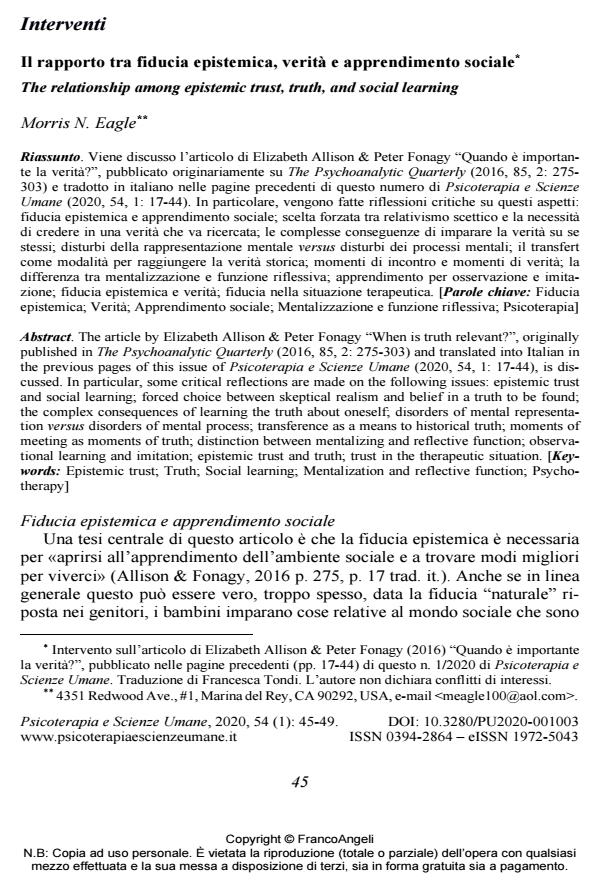The relationship among epistemic trust, truth, and social learning
Journal title PSICOTERAPIA E SCIENZE UMANE
Author/s Morris N. Eagle
Publishing Year 2020 Issue 2020/1 Language Italian
Pages 5 P. 45-49 File size 62 KB
DOI 10.3280/PU2020-001003
DOI is like a bar code for intellectual property: to have more infomation
click here
Below, you can see the article first page
If you want to buy this article in PDF format, you can do it, following the instructions to buy download credits

FrancoAngeli is member of Publishers International Linking Association, Inc (PILA), a not-for-profit association which run the CrossRef service enabling links to and from online scholarly content.
The article by Elizabeth Allison & Peter Fonagy "When is truth relevant?", originally published in The Psychoanalytic Quarterly (2016, 85, 2: 275-303) and translated into Italian in the previous pages of this issue of Psicoterapia e Scienze Umane (2020, 54, 1: 17-44), is discussed. In particular, some critical reflections are made on the following issues: epistemic trust and social learning; forced choice between skeptical realism and belief in a truth to be found; the complex consequences of learning the truth about oneself; disorders of mental representation versus disorders of mental process; transference as a means to historical truth; moments of meeting as moments of truth; distinction between mentalizing and reflective function; observational learning and imitation; epistemic trust and truth; trust in the therapeutic situation.
Keywords: Epistemic trust; Truth; Social learning; Mentalization and reflective function; Psychotherapy
- Allison E. & Fonagy P. (2016). When is truth relevant? Psychoanalytic Quarterly, 85, 2: 275-303.
- Bowlby J. (1988). A Secure Base. London: Routledge (trad. it.: Una base sicura. Milano: Raffaello Cortina, 1989).
- Connolly M.B., Crits-Christoph P., Barber J.P. & Luborsky L. (2000). Transference patterns in the therapeutic relationship in supportive-expressive psychotherapy for depression. Psychotherapy Research, 10, 3: 356-372.
- Dennett D.C. (1987). The Intentional Stance. Cambridge, MA: MIT Press (trad. it.: L’atteggiamento intenzionale. Bologna: Il Mulino, 1993).
- Fonagy P. (1999). Memory and therapeutic action (Guest editorial). International Journal of Psychoanalysis, 80, 2: 215-223.
- Freud S. (1915 [1917]). Metapsicologia. Lutto e melanconia. In: Opere, 8: 102-118. Torino: Boringhieri, 1976.
- Fried D., Crits-Christoph P. & Luborsky, L. (1992). The first empirical demonstration of transference in psychotherapy. Journal of Nervous & Mental Disease, 180, 5: 326-331. DOI: 10.1097/00005053-199205000-00007
- Gill M.M. (1994). Psychoanalysis in Transition: A Personal View. Hillsdale, NJ: Analytic Press (trad. it.: Psicoanalisi in transizione. Milano: Raffaello Cortina, 1996).
- Ibsen H. (1884). Vildanden (trad. inglese: The Wild Duck; trad. it.: L’anitra selvatica).
- Ma F., Chen B., Xu F., Lee K. & Hyman G.D. (2018). Generalized trust predicts young children’s willingness to delay gratification. Journal of Experimental Child Psychology, 169: 118-125.
- O’Neill E. (1939). The Iceman Cometh (trad. it.: Arriva l'uomo del ghiaccio).
- Rank O. (1929). Wahrheit und Wirklichkeit. Entwurf einer Philosophie des Seelischen. Leipzig: Deuticke (trad. inglese: Truth and Reality: A Life History of the Human Will. New York: Knopf, 1936; New York: Norton, 1978; in italiano, vedi: Verità e realtà. In: Essere felici. La forza creativa della volontà. Roma: Castelvecchi, 2015, pp. 45-55).
- Taylor S.E., Kemeny M.E., Reed G.M., Bower J.E. & Greenwald T.L. (2000). Psychological resources, positive illusions and health. American Psychologist, 55: 99-109.
- Risposta agli interventi di Morris N. Eagle, Mauro Fornaro e George Silberschatz Elisabeth Allison, Peter Fonagy, in PSICOTERAPIA E SCIENZE UMANE 1/2020 pp.59
DOI: 10.3280/PU2020-001006
Morris N. Eagle, Interventi. Il rapporto tra fiducia epistemica, verità e apprendimento sociale in "PSICOTERAPIA E SCIENZE UMANE" 1/2020, pp 45-49, DOI: 10.3280/PU2020-001003